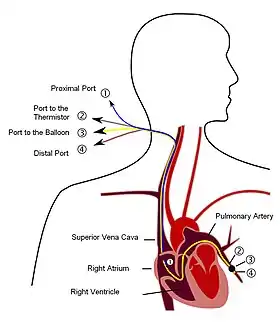
The pulmonary wedge pressure (PWP) (also called pulmonary arterial wedge pressure (PAWP), pulmonary capillary wedge pressure (PCWP), pulmonary artery occlusion pressure (PAOP), or cross-sectional pressure) is the pressure measured by wedging a pulmonary artery catheter with an inflated balloon into a small pulmonary arterial branch.[1] It estimates the left atrial pressure.
Pulmonary venous wedge pressure (PVWP) is not synonymous with the above; PVWP has been shown to correlate with pulmonary artery pressures in studies, albeit unreliably.
Physiologically, distinctions can be drawn among pulmonary artery pressure, pulmonary capillary wedge pressure, pulmonary venous pressure and left atrial pressure, but not all of these can be measured in a clinical context.[2]
Noninvasive estimation techniques have been proposed.[3]
Clinical significance
| Site | Normal pressure range (in mmHg)[4] | |
|---|---|---|
| Central venous pressure | 3–8 | |
| Right ventricular pressure | systolic | 15–30 |
| diastolic | 3–8 | |
| Pulmonary artery pressure | systolic | 15–30 |
| diastolic | 4–12 | |
| Pulmonary vein/ |
2–15 | |
| Left ventricular pressure | systolic | 100–140 |
| diastolic | 3–12 | |
Because of the large compliance of pulmonary circulation, it provides an indirect measure of the left atrial pressure.[5]
For example, it is considered the gold standard for determining the cause of acute pulmonary edema; this is likely to be present at a PWP of >20mmHg. It has also been used to diagnose severity of left ventricular failure and mitral stenosis,[6] given that elevated pulmonary capillary wedge pressure strongly suggests failure of left ventricular output.[7]
Traditionally, it was believed that pulmonary edema with normal PWP suggested a diagnosis of acute respiratory distress syndrome (ARDS) or non cardiogenic pulmonary edema (as in opiate poisoning). However, since capillary hydrostatic pressure exceeds wedge pressure once the balloon is deflated (to promote a gradient for forward flow), a normal wedge pressure cannot conclusively differentiate between hydrostatic pulmonary edema and ARDS.
Physiological pressure: 6–12 mm Hg.[8]
References
- ↑ Peacock, Andrew J.; Lewis J. Rubin (2004). Pulmonary Circulation: Diseases and their treatment. Arnold Publisher. ISBN 978-0-340-80782-8.
- ↑ Chaliki HP, Hurrell DG, Nishimura RA, Reinke RA, Appleton CP (July 2002). "Pulmonary venous pressure: relationship to pulmonary artery, pulmonary wedge, and left atrial pressure in normal, lightly sedated dogs". Catheterization and Cardiovascular Interventions. 56 (3): 432–8. doi:10.1002/ccd.10203. PMID 12112902. S2CID 25152352.
- ↑ Uzun M, Erinc K, Kirilmaz A, et al. (November 2004). "A novel method to estimate pulmonary artery wedge pressure using the downslope of the Doppler mitral regurgitant velocity profile". Echocardiography. 21 (8): 673–9. doi:10.1111/j.0742-2822.2004.03174.x. PMID 15546367. S2CID 25261136.
- ↑ Table 30-1 in: Goers TA, Klingensmith ME, Chen LE, Glasgow SC (2008). The Washington Manual of Surgery. Philadelphia: Wolters Kluwer Health/Lippincott Williams & Wilkins. ISBN 978-0-7817-7447-5.
- ↑ "Gun Shot Wound Case Study Discussion". Archived from the original on 2009-01-08. Retrieved 2009-03-02.
- ↑ "CV Physiology".
- ↑ Harrison's Principles of Internal Medicine. 14th edition. Chapter 38, page 243.
- ↑ "Pulmonary Capillary Wedge Pressure". 22 July 2020.
External links
- Overview at cvphysiology.com
- Pulmonary+wedge+pressure at the U.S. National Library of Medicine Medical Subject Headings (MeSH)